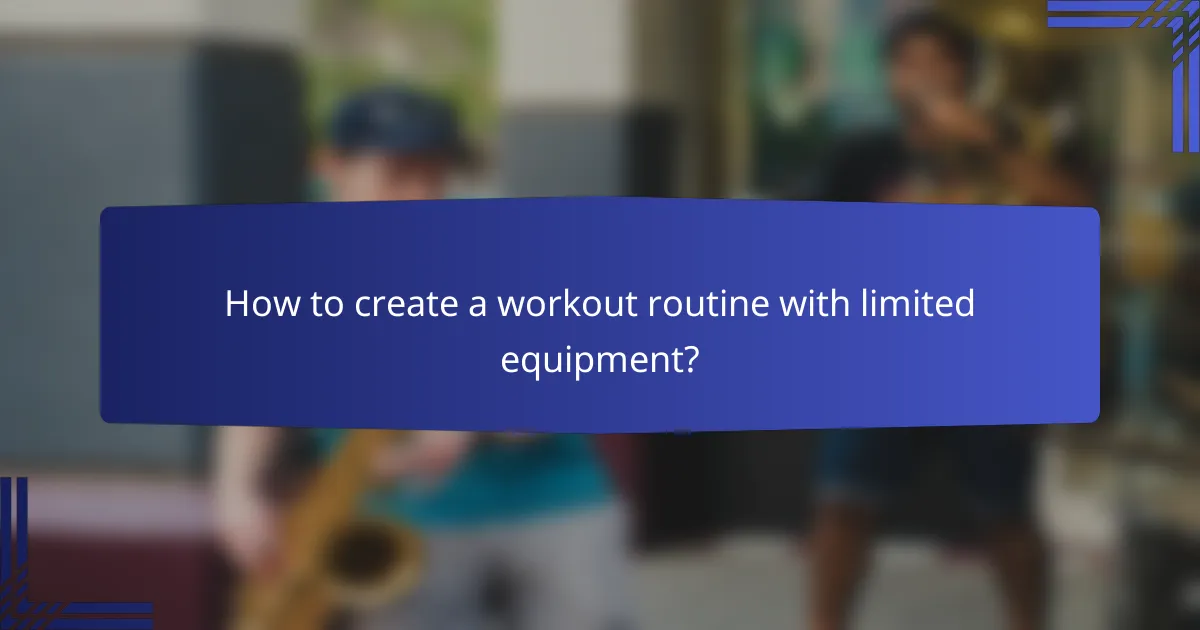Creating a budget-friendly home gym requires careful selection of versatile equipment and efficient use of available space. By prioritizing essential items that maximize value and functionality, you can achieve your fitness goals without overspending. Implementing smart storage solutions and an effective layout will further enhance your workout experience, even in limited areas.

How to set up a budget-friendly home gym in the USA?
Setting up a budget-friendly home gym in the USA involves selecting versatile equipment, utilizing available space efficiently, and considering cost-effective alternatives. Focus on essential items that offer the most value for your fitness goals while keeping expenses manageable.
Essential equipment for low-cost setups
To create a low-cost home gym, prioritize equipment that provides a full-body workout. Items like resistance bands, dumbbells, and a stability ball are affordable and versatile. A good quality yoga mat can also enhance your workout experience without breaking the bank.
Consider multi-use equipment such as a pull-up bar or a bench that can be used for various exercises. Look for second-hand options or sales to find quality gear at lower prices. Aim to spend around $100 to $300 for a basic setup that covers most fitness needs.
DIY options for gym equipment
Creating your own gym equipment can significantly reduce costs. For instance, you can fill a backpack with books or use water jugs as weights. A sturdy chair can serve as a bench for bodyweight exercises, and homemade resistance bands can be crafted from old bicycle inner tubes.
Online tutorials provide guidance on building items like squat racks or plyometric boxes using inexpensive materials. Just ensure any DIY equipment is safe and stable to prevent injuries during workouts.
Space-saving gym design tips
To optimize space in your home gym, choose foldable or stackable equipment that can be easily stored when not in use. Wall-mounted racks for weights and resistance bands can keep your area organized and clutter-free. Consider using corners or under furniture for storage.
Designate a specific area for workouts, even if it’s just a small corner of a room. Use mirrors to create a sense of openness and enhance motivation. Aim for a layout that allows for movement and flexibility, ensuring you can perform a variety of exercises without feeling cramped.

What are the best equipment choices for home gyms?
The best equipment choices for home gyms focus on versatility, space efficiency, and affordability. Prioritize items that allow for a wide range of exercises while fitting within your budget and available space.
Top-rated budget fitness equipment
When setting up a home gym on a budget, consider essential equipment like adjustable dumbbells, resistance bands, and a stability ball. These items are often available for under $100 and can provide a comprehensive workout experience.
Additionally, items such as a jump rope or a yoga mat can enhance your routine without breaking the bank. Look for sales or second-hand options to maximize your savings while still acquiring quality gear.
Comparison of resistance bands and weights
Resistance bands and weights each have unique benefits for home workouts. Bands are lightweight, portable, and versatile, making them ideal for strength training and rehabilitation exercises. They can be easily adjusted for different resistance levels.
Weights, on the other hand, offer a more traditional approach to strength training and can provide a greater range of resistance. However, they require more space and can be more expensive. Consider your fitness goals and available space when choosing between the two.
Best cardio machines for small spaces
For small spaces, compact cardio machines like folding treadmills, stationary bikes, and ellipticals are excellent choices. These machines can be stored away when not in use, making them ideal for limited areas.
Look for models that offer multiple workout programs and adjustable resistance to keep your routine engaging. Additionally, consider options like mini steppers or under-desk bikes, which can provide effective cardio workouts without taking up much room.

How to optimize space for a home gym?
To optimize space for a home gym, focus on efficient layout, versatile equipment, and smart storage solutions. This approach maximizes functionality while minimizing clutter, making it easier to maintain a workout routine in limited areas.
Effective layout strategies
Begin by assessing the available space and identifying areas that can be dedicated to your gym. Consider using corners or underutilized rooms to set up your workout area. A well-planned layout should allow for easy movement and access to equipment.
Use a combination of vertical and horizontal space. Wall-mounted racks and shelves can hold equipment off the floor, while mirrors can create the illusion of a larger space and help with form during workouts. Aim for a layout that promotes flow and accessibility.
Multi-use equipment recommendations
Selecting multi-use equipment can significantly reduce the amount of space needed for your home gym. Consider items like adjustable dumbbells, resistance bands, or a bench that can be used for various exercises. These options provide versatility without requiring excessive room.
Another great choice is a squat rack that doubles as a pull-up bar, allowing you to perform multiple exercises with one piece of equipment. Look for compact cardio machines, such as folding treadmills or stationary bikes, which can be stored away when not in use.
Storage solutions for small areas
Efficient storage is crucial in a small home gym. Use baskets or bins to organize smaller items like weights and bands, keeping them off the floor. Wall-mounted hooks or pegboards can hold larger equipment, ensuring everything is easily accessible yet neatly stored.
Consider furniture that serves dual purposes, such as a storage ottoman that can hold yoga mats or foam rollers. Regularly declutter and reassess your equipment to ensure you only keep what you use, which will help maintain a tidy and functional workout space.

What are the key considerations for home gym equipment selection?
When selecting home gym equipment, prioritize factors such as durability, size, and weight specifications to ensure your setup meets your fitness needs and space constraints. Understanding these considerations helps you make informed choices that fit both your budget and workout goals.
Durability and warranty factors
Durability is crucial for home gym equipment, as it determines how long your investment will last under regular use. Look for equipment made from high-quality materials, such as steel frames and heavy-duty plastics, which can withstand wear and tear.
Warranties can provide peace of mind, so consider products that offer substantial coverage, typically ranging from one to several years. A longer warranty often indicates the manufacturer’s confidence in their product’s durability.
Size and weight specifications
Size and weight specifications are vital for optimizing your home gym space. Measure the area where you plan to set up your equipment to ensure it fits comfortably without overcrowding. Compact options, like foldable benches or adjustable dumbbells, can save space while still providing effective workouts.
Additionally, consider the weight of the equipment itself, especially if you need to move it frequently. Lightweight options are easier to handle, while heavier equipment may offer more stability during use. Aim for a balance that suits your strength and mobility needs.

How to create a workout routine with limited equipment?
Creating a workout routine with limited equipment involves focusing on bodyweight exercises and utilizing minimal gear effectively. Prioritize compound movements that engage multiple muscle groups to maximize your workout efficiency.
Bodyweight exercises for home workouts
Bodyweight exercises are ideal for home workouts as they require no equipment and can be performed in small spaces. Key exercises include push-ups, squats, lunges, and planks, which target major muscle groups and improve strength and endurance.
To enhance your routine, consider variations like incline push-ups or single-leg squats to increase difficulty. Aim for 3-4 sets of 8-15 repetitions for each exercise, adjusting based on your fitness level.
Sample workout plans for small spaces
For small spaces, a simple workout plan can be structured around bodyweight exercises. A typical session might include a circuit of push-ups, squats, and planks, performed for 30 seconds each with 15 seconds of rest in between.
Consider a weekly schedule that alternates focus areas, such as upper body, lower body, and core. This approach allows for recovery while ensuring a balanced workout routine. Aim for at least three sessions per week to see progress.

What are the benefits of a home gym?
A home gym offers numerous advantages, including cost savings, convenience, and flexibility. By creating a dedicated workout space at home, individuals can tailor their fitness routines to their schedules and preferences, ultimately leading to better adherence and results.
Cost savings over time
Investing in a home gym can lead to significant cost savings in the long run. While the initial setup may require a moderate investment, avoiding ongoing gym membership fees, travel expenses, and additional costs for classes can add up to substantial savings over time.
For example, if a gym membership costs around $50 per month, that totals about $600 annually. In contrast, purchasing essential equipment like dumbbells, a yoga mat, and resistance bands can be a one-time expense that pays off within a year or two.
Convenience and flexibility
Having a home gym provides unmatched convenience and flexibility for workouts. You can exercise whenever it fits your schedule, whether early in the morning or late at night, without worrying about gym hours or commuting time.
This flexibility allows for quick workouts, such as a 20-minute high-intensity interval training session, which can easily fit into a busy day. Additionally, you can customize your workouts to suit your preferences, whether that means focusing on strength training, yoga, or cardio.

What are the latest trends in home gym setups?
Recent trends in home gym setups focus on affordability, space efficiency, and technology integration. Homeowners are increasingly opting for multifunctional equipment and smart technology to enhance their workout experience while maximizing limited space.
Smart fitness technology integration
Smart fitness technology is becoming a staple in home gym setups, allowing users to track their progress and enhance their workouts. Devices like smart scales, fitness trackers, and connected equipment provide real-time feedback and personalized workout plans.
When integrating smart technology, consider compatibility with existing devices and apps. Look for equipment that syncs with popular fitness platforms, enabling seamless tracking of metrics like heart rate, calories burned, and workout duration.
Common pitfalls include over-reliance on technology and neglecting basic fitness principles. Aim for a balance between using smart tools and maintaining a consistent workout routine. Prioritize equipment that offers versatility and adaptability to your fitness goals.
